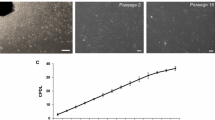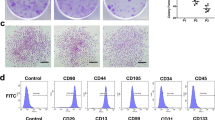Abstract
Cell therapy using adult stem cells has emerged as a potentially new approach for the treatment of various diseases. Therefore, it is an essential procedure to maintain the stemness of adult stem cells for clinical treatment. We previously reported that human dermal stem/progenitor cells (hDSPCs) can be enriched using collagen type IV. However, hDSPCs gradually lose their stem cell properties as in vitro passages continue. In the present study, we developed optimized in vitro culture condition to improve the stemness of these hDSPCs. To evaluate whether the stemness of hDSPCs is well sustained in various culture conditions, we measured the expression levels of SOX2, NANOG, and S100B, which are well-known representative dermal progenitor markers. We observed that hDSPCs grown in three-dimensional (3D) culture condition had higher expression levels of those markers compared with hDSPCs grown in two-dimensional (2D) culture condition. Under the 3D culture condition, we further demonstrated that a high glucose (4.5 g/L) concentration enhanced the expression levels of the dermal progenitor markers, whereas O2 concentration did not affect. We also found that skin-derived precursor (SKP) culture medium was the most effective, among various culture media, in increasing the dermal progenitor marker expression. We finally demonstrated that this optimized culture condition enhanced the expression level of human telomerase reverse transcriptase (hTERT), the proliferation, and the multipotency of hDSPCs, an important characteristic of stem cells. Taken together, these results suggested that this novel in vitro culture condition improves the stemness of hDSPCs.
Similar content being viewed by others
References
Amoh, Y., Li, L., Campillo, R., Kawahara, K., Katsuoka, K., Penman, S., and Hoffman, R.M. (2005). Implanted hair follicle stem cells form Schwann cells that support repair of severed peripheral nerves. Proc. Natl. Acad. Sci. USA 102, 17734–17738.
Biernaskie, J., Paris, M., Morozova, O., Fagan, B.M., Marra, M., Pevny, L., and Miller, F.D. (2009). SKPs derive from hair follicle precursors and exhibit properties of adult dermal stem cells. Cell Stem Cell 5, 610–623.
Blanpain, C., and Fuchs, E. (2006). Epidermal stem cells of the skin. Annu. Rev. Cell Dev. Biol. 22, 339–373.
Bodnar, A.G., Ouellette, M., Frolkis, M., Holt, S.E., Chiu, C.P., Morin, G.B., Harley, C.B., Shay, J.W., Lichtsteiner, S., and Wright, W.E. (1998). Extension of life-span by introduction of telomerase into normal human cells. Science 279, 349–352.
Chen, X.D., Dusevich, V., Feng, J.Q., Manolagas, S.C., and Jilka, R.L. (2007). Extracellular matrix made by bone marrow cells facilitates expansion of marrow-derived mesenchymal progenitor cells and prevents their differentiation into osteoblasts. J. Bone Miner. Res. 22, 1943–1956.
Driskell, R.R., Giangreco, A., Jensen, K.B., Mulder, K.W., and Watt, F.M. (2009). Sox2-positive dermal papilla cells specify hair follicle type in mammalian epidermis. Development 7136, 2815–2823.
Driskell, R.R., Juneja, V.R., Connelly, J.T., Kretzschmar, K., Tan, D. W., and Watt, F.M. (2012). Clonal growth of dermal papilla cells in hydrogels reveals intrinsic differences between Sox2-positive and -negative cells in vitro and in vivo. J. Invest. Dermatol. 132, 1084–1093.
Ezashi, T., Das, P., and Roberts, R.M. (2005). Low O2 tensions and the prevention of differentiation of hES cells. Proc. Natl. Acad. Sci. USA 102, 4783–4788.
Fernandes, K.J., McKenzie, I.A., Mill, P., Smith, K.M., Akhavan, M., Barnabé-Heider, F., Biernaskie, J., Junek, A., Kobayashi, N.R., Toma, J.G., et al. (2004). A dermal niche for multipotent adult skin-derived precursor cells. Nat. Cell Biol. 6, 1082–1093.
Fuchs, E. (2009). Finding one’s niche in the skin. Cell Stem Cell 4, 499–502.
Grayson, W.L., Zhao, F., Bunnell, B., and Ma, T. (2007). Hypoxia enhances proliferation and tissue formation of human mesenchymal stem cells. Biochem. Biophys. Res. Commun. 358, 948–953.
Hill, R.P., Gledhill, K., Gardner, A., Higgins, C.A., Crawford, H., Lawrence, C., Hutchison, C.J., Owens, W.A., Kara, B., James, S. E., et al. (2012). Generation and characterization of multipotent stem cells from established dermal cultures. PLoS One 7, e50742.
Jaskelioff, M., Muller, F.L., Paik, J.H., Thomas, E., Jiang, S., Adams, A.C., Sahin, E., Kost-Alimova, M., Protopopov, A., Cadiñanos, J., et al. (2011). Telomerase reactivation reverses tissue degeneration in aged telomerase-deficient mice. Nature 469, 102–106.
Jiang, Y., Jahagirdar, B.N., Reinhardt, R.L., Schwartz, R.E., Keene, C.D., Ortiz-Gonzalez, X.R., Reyes, M., Lenvik, T., Lund, T., Blackstad, M., et al. (2002a). Pluripotency of mesenchymal stem cells derived from adult marrow. Nature 418, 41–49.
Jiang, Y., Vaessen, B., Lenvik, T., Blackstad, M., Reyes, M., and Verfaillie, C.M. (2002b). Multipotent progenitor cells can be isolated from postnatal murine bone marrow, muscle, and brain. Exp. Hematol. 30, 896–904.
Kim, S.M., Moon, S.H., Lee, Y., Kim, G.J., Chung, H.M., and Choi, Y.S. (2013). Alternative xeno-free biomaterials derived from human umbilical cord for the self-renewal ex-vivo expansion of mesenchymal stem cells. Stem Cells Dev. 22, 1–14.
Kuroda, Y., Kitada, M., Wakao, S., Nishikawa, K., Tanimura, Y., Makinoshima, H., Goda, M., Akashi, H., Inutsuka, A., Niwa, A., et al. (2010). Unique multipotent cells in adult human mesenchymal cell populations. Proc. Natl. Acad. Sci. USA 107, 8639–8643.
Minchenko, A., Bauer, T., Salceda, S., and Caro, J. (1994). Hypoxic stimulation of vascular endothelial growth factor expression in vitro and in vivo. Lab Invest. 71, 374–379.
Ohyama, M., Terunuma, A., Tock, C.L., Radonovich, M.F., Pise-Masison, C.A., Hopping, S.B., Brady, J.N., Udey, M.C., and Vogel, J.C. (2006). Characterization and isolation of stem cell enriched human hair follicle bulge cells. J. Clin. Invest. 116, 249–260.
Pereira, R.F., Halford, K.W., O’Hara, M.D., Leeper, D.B., Sokolov, B.P., Pollard, M.D., Bagasra, O., and Prockop, D.J. (1995). Cultured adherent cells from marrow can serve as long lasting precursor cells for bone, cartilage, and lung in irradiated mice. Proc. Natl. Acad. Sci. USA 92, 4857–4861.
Pittenger, M.F., Mackay, A.M., Beck, S.C., Jaiswal, R.K., Douglas, R., Mosca, J.D., Moorman, M.A., Simonetti, D.W., Craig, S., and Marshak, D.R. (1999). Multilineage potential of human mesenchymal stem cells. Science 284, 143–147.
Reiter, M., Pfaffl, M.W., Schönfelder, M., and Meyer, H.H. (2008). Gene expression in hair follicle dermal papilla cells after treatment with stanozolol. Biomark Insights. 4, 1–8.
Ren, H., Cao, Y., Zhao, Q., Li, J., Zhou, C., Liao, L., Jia, M., Zhao, Q., Cai, H., Han, Z.C., et al. (2006). Proliferation and differentiation of bone marrow stromal cells under hypoxic conditions. Biochem. Biophys. Res. Commun. 347, 12–21.
Rendl, M., Lewis, L., and Fuchs, E. (2005). Molecular dissection of mesenchymal-epithelial interactions in the hair follicle. PLoS Biol. 3, e331.
Riekstina, U., Cakstina, I., Parfejevs, V., Hoogduijn, M., Jankovskis, G., Muiznieks, I., Muceniece, R., and Ancans, J. (2009). Embryonic stem cell marker expression pattern in human mesenchymal stem cells derived from bone marrow, adipose tissue, heart and dermis. Stem Cell Rev. 5, 378–386.
Shin, D.W., Kim, S.N., Lee, S.M., Lee, W., Song, M.J., Park, S.M., Lee, T.R., Baik, J.H., Kim, H.K., Hong, J.H., et al. (2009). (-)-Catechin promotes adipocyte differentiation in human bone marrow mesenchymal stem cells through PPAR gamma transactivation. Biochem. Pharmacol. 77, 125–133.
Shim, J.H., Kang, H.H., Lee, T.R., and Shin, D.W. (2012). Enrichment and characterization of human dermal stem/progenitor cells using collagen type IV. J. Dermatol. Sci. 67, 202–205.
Shim, J.H., Lee, T.R., and Shin, D.W. (2013). Enrichment and characterization of human dermal stem/progenitor cells by intracellular granularity. Stem Cells Dev. 22, 1264–1274.
Szade, K., Zuba-Surma, E., Rutkowski, A.J., Jozkowicz, A., and Dulak, J. (2011). CD45-CD14 +CD34 + murine bone marrow low-adherent mesenchymal primitive cells preserve multilineage differentiation potential in long-term in vitro culture. Mol. Cells 31, 497–507.
Toma, J.G., Akhavan, M., Fernandes, K.J., Barnabé-Heider, F., Sadikot, A., Kaplan, D.R., and Miller, F.D. (2001). Isolation of multipotent adult stem cells from the dermis of mammalian skin. Nat. Cell Biol. 3, 778–784.
Toma, J.G., McKenzie, I.A., Bagli, D., and Miller, F.D. (2005). Isolation and characterization of multipotent skin-derived precursors from human skin. Stem Cells 23, 727–737.
Wegner, M., and Stolt, C.C. (2005). From stem cells to neurons and glia: a Soxist’s view of neural development. Trends Neurosci. 28, 583–588.
Wu, Y., Zhao, R.C., and Tredget, E.E. (2010). Concise review: bone marrow-derived stem/progenitor cells in cutaneous repair and regeneration. Stem Cells 28, 905–915.
Wyllie, F.S., Jones, C.J., Skinner, J.W., Haughton, M.F., Wallis, C., Wynford-Thomas, D., Faragher, R.G., and Kipling, D. (2000). Telomerase prevents the accelerated cell ageing of Werner syndrome fibroblasts. Nat. Genet. 24, 16–17.
Yoon, J., Choi, S.C., Park, C.Y., Shim, W.J., and Lim, D.S. (2007). Cardiac side population cells exhibit endothelial differentiation potential. Exp. Mol. Med. 39, 653–662.
Zuk, P.A., Zhu, M., Mizuno, H., Huang, J., Futrell, J.W., Katz, A.J., Benhaim, P., Lorenz, H.P., and Hedrick, M.H. (2001). Multilineage cells from human adipose tissue: implications for cellbased therapies. Tissue Eng. 7, 211–218.
Zuk, P.A., Zhu, M., Ashjian, P., De Ugarte, D.A., Huang, J.I., Mizuno, H., Alfonso, Z.C., Fraser, J.K., Benhaim, P., and Hedrick, M.H. (2002). Human adipose tissue is a source of multipotent stem cells. Mol. Biol. Cell. 13, 4279–4295.
Author information
Authors and Affiliations
Corresponding authors
About this article
Cite this article
Shim, J.H., Lee, T.R. & Shin, D.W. Novel in vitro culture condition improves the stemness of human dermal stem/progenitor cells. Mol Cells 36, 556–563 (2013). https://doi.org/10.1007/s10059-013-0260-1
Received:
Accepted:
Published:
Issue Date:
DOI: https://doi.org/10.1007/s10059-013-0260-1




